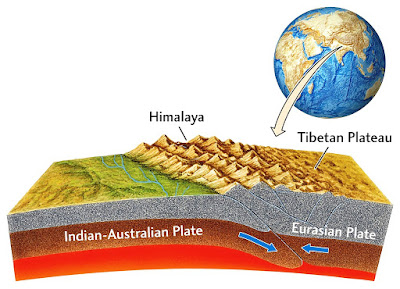Himalayan migration northward found to be result of tectonic lift
 |
| Himalayan migration northward found to be result of tectonic lift |
A trio of researchers has found evidence to suggest that a very large gorge in an eastern part of the Himalayas is moving slowly northward due to pressure from tectonic lift.
In their paper published in the journal Science, Georgina King and Fr?d?ric Herman with the University of Lausanne in Switzerland and Benny Guralnik with Wageningen University in The Netherlands describe how they used a new type of technology to measure the age of minerals beneath the surface in the area to determine how rapidly rock has been moving toward the surface.
Scientists have for years debated the different parts that erosion and plate tectonic shifting play in changing the shape of the Himalayas, with many suggesting that erosion is likely the main driver due to the forces of wind, freezing and thawing, precipitation and especially rivers carving their way through rock.
But now it appears the opposite may be true as new technology has allowed for more precise measurements of rock movement speed, an indication of tectonic shifting.
The new technology is called optically stimulated luminescence thermochronometry?it is able to measure electrons that have become trapped in a material such as quartz or feldspar, which in turn allows for measuring rock movement.
This is possible because as plates shift, pushing rock towards the surface, the rock slowly cools down and as it does so electrons become trapped in it. Thus, measuring those electrons allows for measuring how recently the rock in which they are trapped was moved to its current location and that offers information about changes to the landscape due to tectonic shifting. The technology is able to place the age of rocks to approximately 200,000 years ago.
The researchers gathered samples from five different locations along an eastern part of the Himalayan region known as Namche Barwa?prior research had shown the area to be heavily impacted by both tectonic lift and erosion.
Their results suggest that dual factors contributing to changes in the landscape are coincidence rather than one causing the other as some in the field have suggested and that tectonic lift plays a far more important role in topological deformation in the area.
Journal reference: Science
DOI: 10.1126/science.aaf2637